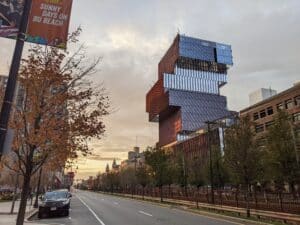Most of the 320 buildings that comprise Boston University’s Charles River campus fit unassumingly into the urban landscape.
That all started to change in 2020, when Suffolk Construction broke ground on the school’s new 19-story Center for Computing and Data Sciences at 665 Commonwealth Ave. The building has become widely compared to a Jenga tower for its irregular stacked silhouette.
Now the $290-million project is up for global acclaim at the World Architecture Festival, which begins Nov. 29 in Singapore. It’s one of 250 buildings nominated for building of the year in the higher education and research category.
Walt Meissner, Boston University’s assistant vice president for operations, said the project was designed to make a bold statement from the outset.
“We wanted a building everyone will have a remark about,” Meissner said.
In the most far-reaching architectural competition in the school’s history, BU officials contacted 55 firms from around the world that are known for designing iconic buildings. A university committee including President Robert Brown narrowed the list to 18 firms and issued a request for proposals.
Toronto-based architects KPMB’s presentation stood out among the five finals.
“The way they presented it, there was a real `wow’ factor, and we really responded to that,” Meissner said.
Beyond BU’s internal process, the project had to pass muster by the Boston Civic Design Commission, a city panel that reviews developments’ architectural plans.
“There were one or two people on the design commission that didn’t respond to it as well, and were concerned about how it was going to impact the skyline along the Charles River,” Meissner said. “But after some heavy lobbying and coercing and articulate defenses, they all came around.”
The interior spaces lift a page from the layout of modern office buildings, with an emphasis on collaborative spaces. Conference rooms and classrooms occupy the corners of the floor plates, rather than private offices.
Beyond its striking building envelope, the project has received notice for its aggressive energy sustainability strategy.
A network of 31 underground wells were drilled 1,500 feet below the property and neighboring parcels owned by BU forms the city’s largest geothermal energy system to date.
The system taps into the moderate temperatures below ground to power heating and cooling systems, only switching to electric boilers and chillers in extreme temperatures. When temperatures in Boston plunged below zero in early February, only four of the six electric boilers activated to supply additional heating capacity, Meissner said.
“The initial reviews are we couldn’t be happier,” he said.









